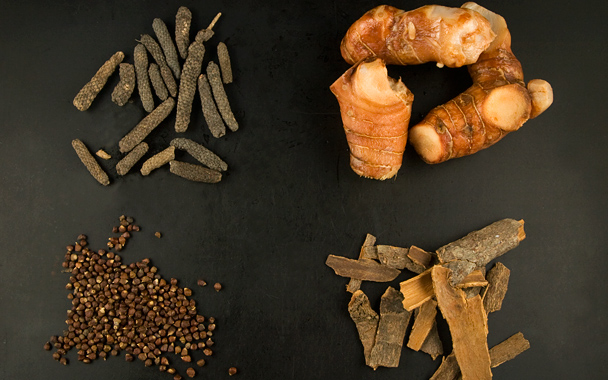Remember back in junior-high history class, when they told you the reason spices were prominent in medieval times was because people relied on them to keep meat from spoiling and to cover the taste of meat already past its prime? Well, they were wrong. For one thing, there were plenty of other, better ways to preserve meat (salting, smoking, pickling, air-drying) available to cooks at the time. More important is the fact that spices were wildly expensive in comparison to the relatively cheap meat. Using pepper or ginger to perk up or extend the shelf life of beef, for example, would have been about as logical as enhancing a fast-food cheeseburger with a mound of shaved truffles.
So what does account for the rampant use of spices and aromatics between roughly the fifth and sixteenth centuries? For starters, taste. Like the Romans, medieval Europeans loved sharp flavors. Traveling with Chaucer’s Canterbury pilgrims was a cook who knew how to use galangal, the ginger-like rhizome we associate with Southeast Asian cuisine today; other cooks regularly turned to such little-known treasures as zedoary (a cousin of turmeric), grains of paradise (a reddish spice from West Africa), and long pepper (deeper than black pepper, to which it is not related) to perk up their recipes.
Certainly the influence of Arabic and Persian cuisines played a role. Via contacts through Spain, trade with Egypt, and the presence of crusader states in the Middle East from 1099 to 1291, rose water, dried fruit, sugar, and almond milk began to show up in such dishes as haddock in Gyve (haddock boiled in spiced fish broth and served with a sauce consisting of more spices, dried fruit, and sugar) or Maymeny (a kind of pudding made with wine, raisins, sugar, spices, and chicken), and in combinations to produce candied spices, gingerbread, and even medicines that nodded to the Middle East and India. Feared infidels or not, Muslims, with their wealth and sophistication, proved serious trendsetters in Christian Europe before the year 1500. The wealth of great cities such as Baghdad, Damascus, and Cairo awoke envy and enchanted Christian Europeans, who felt themselves somewhat behind in style and luxury.
Medieval tastes also inclined toward splendor and ostentation. Innovation and variety were valued over basic ingredients, and such aesthetic ideals as bright coloring (achieved using saffron, for example, for golden yellow; Indian sandalwood for red; and parsley for green) and trompe l’oeil ruled the day. One popular dish involved pheasants that had been cooked and then re-assembled in their plumage to look alive, and another known as “mock eggs” (the real ones were prohibited during Lent) that called for almond milk (for the white) and a paste flavored with cinnamon and saffron. (Michel Richard does a modern-day version of this dish.) Spices were ubiquitous: in sauces that accompanied game, meat, and fish; in sweet wines (such as hippocras and piment); and in cordials such as pliris, a luxury beverage involving musk and camphor.
By the seventeenth century, though, the tide had begun to turn. French cooks especially started to reject spices and other medieval decorations and subterfuges (as they were considered) in favor of European herbs, shallots, and truffles, and of such new methods as reduction, to achieve authentic flavors. The medieval culinary style was dismissed as childish for its love of sweet, sour, and aromatic flavors, and “classic” French cuisine increasingly reared its sober head. Some might point to the hijinks emerging from such kitchens as Ferran Adrià’s and Heston Blumenthal’s to suggest that we’re just now beginning to come full circle.




 Pinterest
Pinterest


